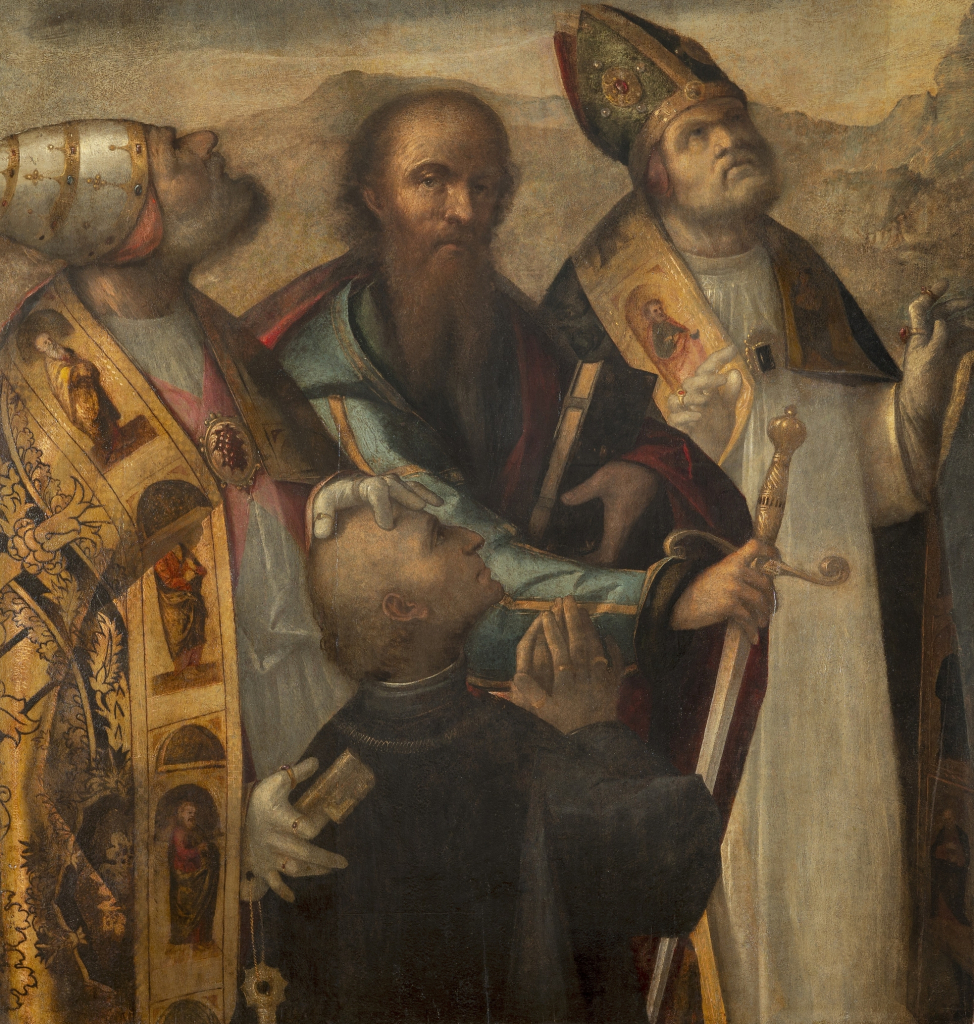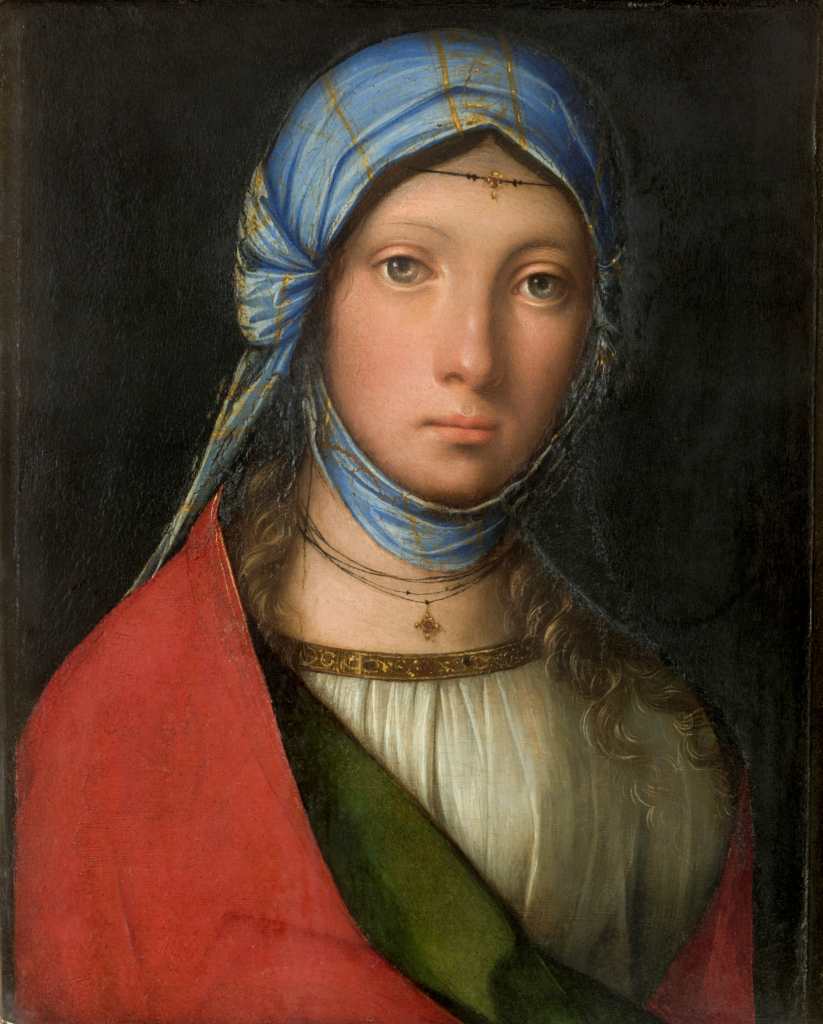In the world of auctions, attention sometimes focuses solely on records and sensational sales — those front-page exploits which, although increasingly rare, dictate the market’s fluctuations. Yet alongside this more spectacular dimension lies another, quieter one that deserves to be told: that of the lots that remain “blank”, unsold, seemingly forgotten. A negative auction outcome does not always reflect the poor quality of a work. On the contrary, in many cases this failure of supply and demand to meet becomes a valuable opportunity for a piece to be re-evaluated and, in some instances, even “saved”.
A telling example concerns a fragment of the monumental Pala Fodri by Boccaccio Boccaccino (Ferrara?, 1462/before 1466 – Cremona, 1525), a painter described as “rare” and “excellent” by Giorgio Vasari, and to be counted among the foremost figures of the Renaissance in northern Italy. Left unsold at Millon’s Cremona auction on 27 September 2023 (lot 31), the painting — meanwhile placed under protection by the Soprintendenza Archeologia, Belle Arti e Paesaggio for the provinces of Cremona, Lodi and Mantua — was subsequently acquired by the Diocesan Museum of Cremona. Not a fallback, then, but a stroke of cultural foresight, capable of restoring to the city a fundamental piece of its artist’s creative trajectory.

The fate of this fragment, once part of an altarpiece commissioned in 1523 by the heirs of Benedetto Fodri for the high altar of the church of San Pietro al Po in Cremona, demonstrates how the workings of the market never fully determine the life of a work of art. Indeed, it was precisely the “missed opportunity” at auction that enabled a virtuous acquisition — one that now allows the public to revisit the final chapter of Boccaccio Boccaccino’s career within a context of research and appreciation.The Diocesan Museum, which already houses masterpieces such as the Annunciazione Ludovisi, the Crocifissione del Duomo, and the Sacra Famiglia con Maria Maddalena formerly in San Luca, thus adds a fourth major work to its collection, reaffirming its role as a leading centre for the study and understanding of the painter. Regardless of the coincidence with the five-hundredth anniversary of the artist’s death, it is no accident that this acquisition has provided the impetus for the first monographic exhibition dedicated to Boccaccino, Il Rinascimento di Boccaccio Boccaccino, curated by the present author together with Filippo Piazza.Boccaccio Boccaccino, Annunciation, c. 1507, Cremona, Diocesan Museum.

The exhibition boasts highly significant loans from the Uffizi Galleries, the Pinacoteca di Brera, the Galleria Estense in Modena, the Capodimonte Museum, the Correr Museum and the Gallerie dell’Accademia in Venice. It retraces the entire career of Boccaccino, from his early Ferrarese works to his Venetian paintings infused with Giorgionesque influences, and through to his final undertakings in Cremona.Boccaccio Boccaccino, Zingarella (The Gypsy Madonna), c. 1504–1505, Florence, Uffizi Galleries.

The exhibition route culminates precisely with the fragment of the Pala Fodri, acquired thanks to that auction which “drew a blank” — an outcome which, paradoxically, has allowed the piece to be reborn.
This episode therefore invites a broader reflection on the virtuous role that auctions can play when they intersect with the forward-looking protection strategies of the Soprintendenze and with the committed acquisition policies of museums. A private collector is not always the ideal custodian of an artwork, especially when the piece is closely tied to a city and its cultural fabric. It is nonetheless worth noting in this case that the responsibility for the purchase did not fall to a local public institution — neither the Municipality of Cremona nor any civic authority — but rather to a private, ecclesiastical institution. It was the Diocesan Museum which, with courage and a strong sense of responsibility, seized the opportunity and restored to public view a work that risked remaining excluded from the shared heritage. This dynamic, on the one hand, confirms the vitality of cultural entities too often dismissed as “peripheral”, while on the other, it reveals a certain reluctance on the part of public institutions, less ready to invest even where the historical and artistic value is clear.
The fragment from the Pala Fodri, once created for an altar in Cremona, could hardly have found a more fitting home than the city’s own Diocesan Museum, where it now enters into dialogue with the paintings that trace the artist’s development and, ideally, with the grand cycle of frescoes depicting the Stories from the Life of the Virgin and the Passion of Christ. That cycle was initiated by Boccaccio Boccaccino himself in 1514 and continued by other masters — among whom, alongside Gianfrancesco Bembo and Altobello Melone, stand out the Brescia-born Girolamo Romanino and the Friulian Giovanni Antonio de’ Sacchis, known as il PordenoneBoccaccio Boccaccino, Birth of the Virgin, 1514–1515, Cremona, Cathedral (Duomo).

Boccaccio Boccaccino, a perceptive interpreter of Leonardo’s teaching in Milan and of the Giorgionesque innovations in Venice, was able to infuse the language of the Po Valley Renaissance with a serene, classicising vein that still astonishes today for its balance and grace. Even in the fragment of the Pala Fodri, despite his advanced age and the later stage of his career, the artist demonstrates his ability to evolve and to maintain a leading role in the commissions of his city. It is not, therefore, a “minor” piece, but a valuable document for understanding the master’s final creative season.
An unsold lot at auction is not a condemnation, but can instead become a moment of redemption: from the hesitant hands of private buyers to the decisive action of a museum choosing to invest in shared heritage by recovering an object of such local identity. In this sense, the Cremona exhibition is not only a tribute to a Renaissance master, but also a celebration of a cultural policy capable of seizing the opportunities offered by the market. It is an important lesson: where the logic of collecting does not immediately recognise value, the foresight of institutions can intervene, transforming an “unsold” work into an opportunity for study, display, and collective understanding.
The fragment of the Pala Fodri, brought back to light after a careful restoration, is therefore not only an image to be admired but also a symbol of this virtuous dynamic. Its presence in the exhibition reminds us, once again, that every work of art has a complex story — made up of movements, dispersals, and rediscoveries — and that it is often these very twists of fate that offer the public the most precious opportunities.
7 November 2025


